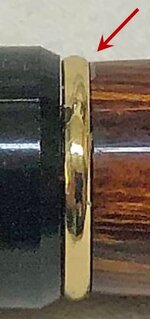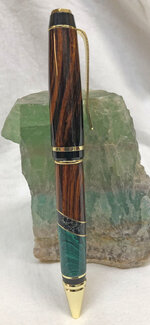egnald
Member
Greetings from Nebraska.
Today I finally turned a segmented blank that I have had laying around for a few months. It is a gold Cigar pen and the blank was made of simple diagonal segments of Malachite SimStone, Black Marble SimStone, and Sonoran Desert Ironwood all separated with some pieces of brass. I think it might have looked better with just a solid black piece of Ebony rather than the Black Marble that has the little white lines in it. I turned it using the custom Cigar bushings from ed4copies (Exotic Blanks) and finished it with my standard CA regimen. I installed a Blue-Black Monteverde Parker Style GEL Refill - Broad point and will be making this one of my every day carry pens.
I really like the fit between blank and the top (transmission) coupler on the lower section from Ed's improved bushing design.

Regards,
Dave

Pictures showing the grain as the pen was rotated:




Today I finally turned a segmented blank that I have had laying around for a few months. It is a gold Cigar pen and the blank was made of simple diagonal segments of Malachite SimStone, Black Marble SimStone, and Sonoran Desert Ironwood all separated with some pieces of brass. I think it might have looked better with just a solid black piece of Ebony rather than the Black Marble that has the little white lines in it. I turned it using the custom Cigar bushings from ed4copies (Exotic Blanks) and finished it with my standard CA regimen. I installed a Blue-Black Monteverde Parker Style GEL Refill - Broad point and will be making this one of my every day carry pens.
I really like the fit between blank and the top (transmission) coupler on the lower section from Ed's improved bushing design.

Regards,
Dave

Pictures showing the grain as the pen was rotated:




Last edited:
